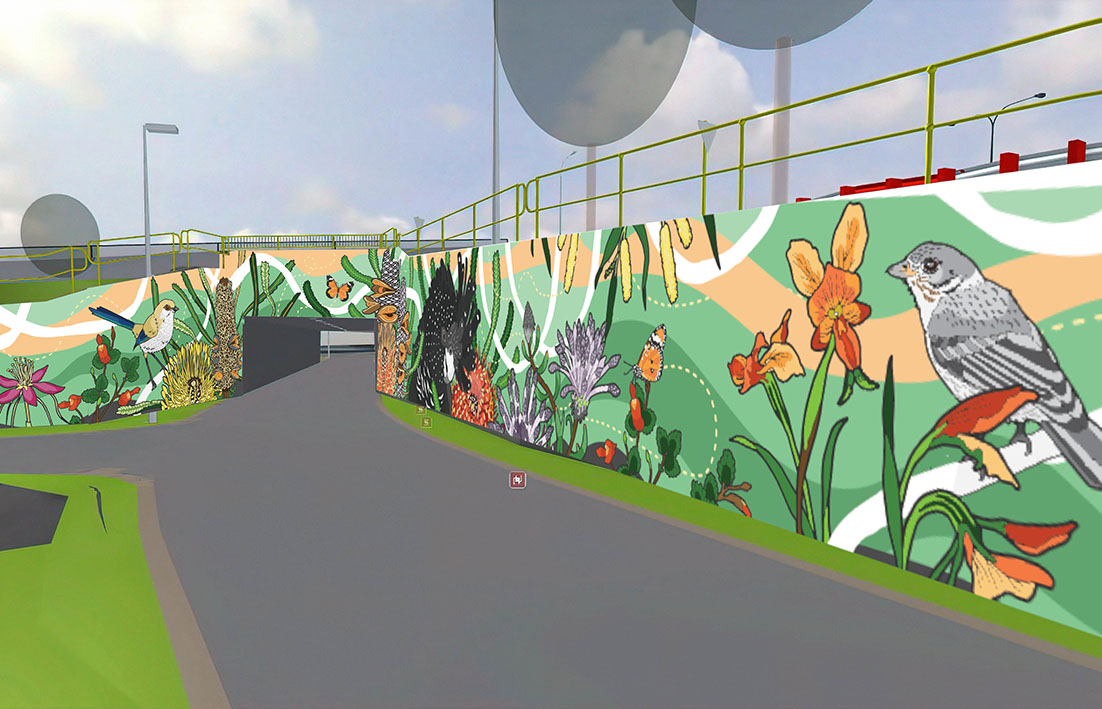
THE Morley-Ellenbrook line project has commissioned 12 local and Noongar artists to create 19 public art pieces across five new stations in the largest Metronet public art collection to date.
The artworks will reflect and celebrate the unique environment of each station, as well as Noongar culture and connection to Country, while supporting opportunities for emerging and established artists.
A series of graphically overlaid glass skylights will feature at each of the five stations.
Created by Whadjuk, Ballardong and Yamatji artist Marcia McGuire and award winning Australian designer Penelope Forlano, the works share and honour concepts of Aboriginal and non-Aboriginal beliefs and are unique to each station.
Metal arbour screens will welcome visitors and passengers to Ellenbrook Station representing it as a ‘place of looking’ for the Whadjuk Noongar people. The works feature the circle stump of the Balga (grass tree), gum tree leaves and peppermint trees – all linked to traditional smoking ceremonies.
Patterned screens, set to be located along sections of the platform, represent the movement of people through changing landscapes, paying respect to the natural environment, and acknowledging traditional custodianship of the Whadjuk Noongar people.
While a bright, bold mural will surround the station’s electrical building, representing the Karla Nara Gyinning Bidi (Ellenbrook train track).
Bidis represent the seasonal movements of animals and people. With a colour palette inspired by fire and landscape, the painting will feature the rainbow serpent from Aboriginal Dreamtime stories, Bennett Brook, native animals and plants and fire.
Whiteman Park station will feature an entry mural that will transform the walls around the station entrance with three giant wedge-tailed eagles in flight and abstract swamp and stout paperbark leaves and flowers. The iconic WA bird of prey is a native species of Whiteman Park.
The underpass mural has images emphasising the ecological and cultural importance of groundwater, and will brighten the Drumpellier Drive pedestrian underpass with representation of Bennett Brook stream, traditional Aboriginal pathways and Whiteman Park’s native flora and fauna.
The Whiteman station will also have four unique arrival sculptural artworks to be positioned in pairs to reflect how Noongar people and families travelled together on Country in search of food and water sources.
The sculptures will be illuminated at night and the colours will reflect the importance of fire (kaarl) and water (kiep) with engravings on the figures telling stories from the past.
Two clusters of sculptural freshwater mussels will feature in landscaping around Whiteman station. The mussels are linked to the well-known nearby Mussel Pool and the Carter’s Freshwater Mussel found in nearby wetlands.
Perforated screens will be located on the concourse of Malaga Station, with the circle at the centre representing Malaga as a place of trading, of many tools (digging sticks), accessories (bags, cloaks) and weapons (shields, spears) which were used for fishing, hunting, daily life and more.
The lines connecting to the inner circle represent the flow of incoming and outgoing trades, while the screens on the facade draw inspiration from the banksia trees around the station and surrounding Bennett Brook – reinforcing a sense of place and discovery.
To find out more about each piece and the artists click here.